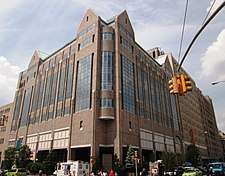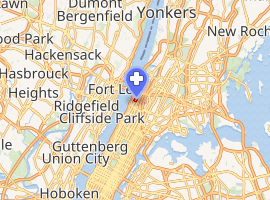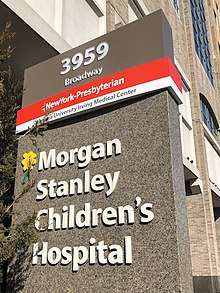Morgan Stanley Children's Hospital
Morgan Stanley Children's Hospital of NewYork-Presbyterian (MSCH or CHONY[3]) is a pediatric hospital at 3959 Broadway, near West 165th Street, in the Washington Heights neighborhood of Manhattan, New York City. It is a part of NewYork-Presbyterian Hospital and the Columbia University Irving Medical Center. The hospital treats patients aged 0–21[4][5][6] from New York City and from around the world.[7][8] The hospital features a dedicated regional ACS designated pediatric Level 1 Trauma Center and is named after financial firm Morgan Stanley, which largely funded its construction through philanthropy.
| Morgan Stanley Children's Hospital | |
|---|---|
| NewYork–Presbyterian Hospital | |
 The front of the hospital pictured in 2014. | |

| |
| Geography | |
| Location | Manhattan, New York, United States |
| Coordinates | 40.8397°N 73.9412°W |
| Organization | |
| Funding | Non-profit hospital |
| Type | Teaching |
| Affiliated university | Columbia University Vagelos College of Physicians and Surgeons |
| Services | |
| Emergency department | Level 1 Pediatric Trauma Center[1] |
| Beds | 299[2] |
| Speciality | Children's hospital |
| History | |
| Opened | 1887 (Babies' Hospital) 2003 (current building) |
| Links | |
| Website | www |
| Lists | Hospitals in New York |
| Other links | Hospitals in Manhattan |

The hospital is affiliated with the Columbia University Vagelos College of Physicians and Surgeons, and many of its physicians are faculty members of the college.[9]
History
The hospital has nearly 250 years of history in treating children, tracing its roots to the establishment of Columbia University's – then King's College – Department of Pediatrics in 1767. Initially founded as Babies Hospital, it was established in 1887 in a Brownstone on 55th Street and Lexington Avenue.[10] At the time of its opening, New York City's hospitals only had 27 beds catering to infants.[11]
In 1929 the hospital moved from its Lexington Avenue site to Upper Manhattan to become part of the Columbia–Presbyterian Medical Center.[12] The hospital underwent various expansions throughout the years and during the planning of the new building the old hospital had 168 beds and 6 operating rooms.[13]

The Babies Hospital
The Babies Hospital, which was New York City's first dedicated hospital for children, was founded in 1887 by Drs. Sarah McNutt and Julia McNutt and three members of the board of New York Infirmary, Jeannie Smith, Isabella Satterthwaite, and Isabella Banks.[14][15]
Soon after its opening, Babies Hospital adopted this as its guiding principle: "The mission of the Babies Hospital is to relieve mental and physical distress, and even though the death rate is increasing thereby, a case is never refused admission because it is hopeless."
In the many decades since its founding, Babies Hospital physicians were instrumental in shaping the field of modern pediatrics and establishing numerous medical subspecialties.[16]
1887-1900
The hospital, which initially had only women resident physicians, had 30 beds for sick infants and children up to three years old, and malnutrition was the most common diagnosis. Its early leaders focused on milk sterilization, proper nutrition, and sanitary practices.[17]
In 1888, L. Emmett Holt was appointed medical director.[16] Under his leadership, Babies Hospital became the leading pediatric hospital of its time.[18][16]
Martha Wollstein, MD, the first fully specialized pediatric perinatal pathologist practicing exclusively in a North American children's hospital, became the pathologist of record at Babies Hospital as of 1892.[19]
Babies Hospital was also the first hospital to use neonatal incubators in the U.S.[16]
1900-1929
In 1900, Babies Hospital affiliated with the Columbia University College of Physicians and Surgeons to help train new doctors in pediatrics.[20] In 1900, the Rockefeller family helped to fund the construction of a new Babies Hospital at its original site. That 10-story building still stands today as Children's Hospital North.[17]
In 1903, Dorothy Reed Mendenhall, one of the first female physicians who discovered the blood cell disorder characteristic of Hodgkin's disease, completed an internship in pediatrics at Babies Hospital.[21]
In 1922, Babies Hospital physicians established the first pediatric radiology service.[10]
Babies Hospital retained an independent corporate identity until it was wholly merged into Presbyterian Hospital on Dec. 31, 1943.[22][23]
The new facility in northern Manhattan had 204 beds for children up to 12 years of age. The New York Times referred to the new Babies Hospital as "the last word in hospital design and equipment," mainly because of revolutionary features such as private and shared patient rooms, playrooms, and a roof garden.[24]
1930-1991
From 1930-1960, Rustin McIntosh, MD, was chief of pediatrics at Babies Hospital. Under his leadership, the hospital was one of the first in the country to develop programs in neonatal care, pediatric surgery, radiology, neurology, hematology-oncology, and psychiatry. As the director of pediatrics at the Columbia University College of Physicians and Surgeons, he assembled a department of noted pediatric subspecialists. These included Dorothy Hansine Andersen (pathology), Hattie Alexander (infectious disease), William Silverman (neonatology), John Caffey (radiology), and James Wolff (Hematology-Oncology).[25]
In 1933, Hattie Elizabeth Alexander, MD, was appointed as an adjunct assistant pediatrician at Babies Hospital. During her tenure at the hospital, she developed a cure for influenza meningitis, which reduced the mortality rate to 20 percent in children and infants.[26] Dr. Alexander was also the first woman elected president of the American Pediatric Society.[27]
In 1936, Donovan McCune, an attending physician at Babies Hospital, first described a rare genetic disorder later known as McCune-Albright syndrome.[17] In 1940, Katharine Krom Merritt and Haig Haigouni Kasabach, pediatricians at Babies Hospital, first described a case of Kasabach-Merritt syndrome in an infant.[28] In 1949, Conrad M. Riley and Richard Lawrence Day identified Riley-Day syndrome, a nervous system disorder affecting children of Eastern European Jewish descent mostly.[29]
In 1953, Babies Hospital anesthesiologist Virginia Apgar, MD, created a easy scoring method for predicting infant health, now known as the "Apgar score."[30] The Apgar score measures five body functions to determine the need for life-saving assistance within a minute of birth and remains the international pediatric standard for assessing newborn health.[31] James Wolff, MD, was a founding member of the Children's Cancer Group, the first cooperative cancer treatment consortium in the United States, and also collaborated with Dr. Vincent Freda to discover the therapy for Rh disease.[25]
In 1959, Baby's hospital physicians developed the sweat test.[32]
In 1968, the hospital once again expanded and erected a new adjacent building.[17]
Shaken Baby syndrome was described in 1972.[33] In 1984, Dr. Eric Rose performed the first successful pediatric heart transplant at Babies Hospital.[34]
1992-Present
In 1992, Dr. John Driscoll was named chairman,[35] and remained chair until he retired in 2007.[16] Dr. Driscoll, a neonatologist, had directed the neonatal intensive care unit since 1971.
In this period, the research of Dr. Anne Gershon was critical to the widespread adoption of the varicella vaccine, which prevents chickenpox.[36]
In 2000, investment bank Morgan Stanley Dean Witter gifted NewYork-Presbyterian more than $55 million to build the Morgan Stanley Dean Witter Children's Hospital at 165th Street and Broadway to replace the Babies and Children's Hospital.[37] In 2003, the Morgan Stanley Children's Hospital of NewYork-Presbyterian opened.[38]
About
In 2019, for the 13th year in a row, NewYork-Presbyterian ranked in more pediatric specialties than any other New York metro area hospital in the 2019-20 rankings by U.S. News & World Report's "Best Children's Hospitals."[39]
NewYork-Presbyterian Morgan Stanley Children's Hospital was named a Level 1 Children's Surgery Center by the American College of Surgeons in 2019.[40] NewYork-Presbyterian Morgan Stanley Children's Hospital is a New York State-designated Regional Perinatal Center, a Level IV Neonatal Intensive Care Unit, and a Level 1 Pediatric Trauma Center.[41]
NewYork-Presbyterian Morgan Stanley Children’s Hospital has 269 beds[42] - including 100 medical/surgical beds, 41 pediatric intensive care beds (including 14 cardiac intensive care beds), and 50 neonatal intensive care beds.[38]
Pediatric ECMO
NewYork-Presbyterian Morgan Stanley Children's Hospital’s pediatric ECMO (Extracorporeal Membrane Oxygenation, which provides heart-lung support) program is one of five programs in the world designated as a Platinum Center of Excellence by the Extracorporeal Life Support Organization (ELSO) for Excellence in Life Support.[43] The ECMO program is provided in either the Neonatal Intensive Care Unit (NICU) or the Pediatric Intensive Care Unit (PICU).
SCID Specialty Care Center
NewYork-Presbyterian Morgan Stanley Children's Hospital is one of a few New York State–designated Severe Combined Immunodeficiency (SCID) Specialty Care Centers.[44] A specialty care center is a healthcare facility established to provide treatment and services to children identified by the newborn screening laboratory.[45]
Center for Autism and the Developing Brain
The Center for Autism and the Developing Brain, located at NewYork-Presbyterian Westchester Behavioral Health Center provides services to patients and families affected by autism. The 11,000-square-foot center was created with $11 million in donations from New York Collaborates for Autism, Jim and Marilyn Simons, Autism Speaks, and the Mortimer D. Sackler Foundation.[46]
Weinberg Family Cerebral Palsy Center
In 2013, Debby and Peter A. Weinberg donated more than $7 million to help establish the Weinberg Family Cerebral Palsy Center.[47] The center provides patient education and helps patients transition from pediatric to adult care when they turn 21.[48]
Research
Pediatric research at NewYork-Presbyterian Morgan Stanley Children’s Hospital is conducted through the Department of Pediatrics at Columbia University Vagelos College of Physicians & Surgeons. The Department of Pediatrics has received more National Institutes of Health research grants than any other pediatric program in the New York metro area.[49]
The physician-researchers at the hospital have made significant advancements in the field of pediatrics, including performing the first successful pediatric heart transplant, identification of cystic fibrosis,[50] and the creation of the Apgar score.[51] NewYork-Presbyterian Morgan Stanley Children’s Hospital is a member of the Food Allergy Research & Education (FARE) Clinical Network to aid in the development of new therapeutics and best practices for the care of patients with food allergies.[52] The FARE Clinical Network consists of 33 Centers of Excellence that develop best practices for the care of patients with food allergies; serve as sites for clinical research; contribute to the development of the FARE Patient Registry and food allergy biorepositories to support food allergy research.[53]
Rankings
As of 2020 Morgan Stanley Children's Hospital and Komansky Children's Hospital have placed nationally in all 10 ranked pediatric specialties on U.S. News and World Report.
| Specialty | Rank (In the U.S.) | Score (Out of 100) |
|---|---|---|
| Neonatology | #21 | 75.2 |
| Pediatric Cancer | #37 | 74.5 |
| Pediatric Cardiology & Heart Surgery | #21 | 72.5 |
| Pediatric Diabetes & Endocrinology | #25 | 70.9 |
| Pediatric Gastroenterology & GI Surgery | #26 | 73.0 |
| Pediatric Nephrology | #37 | 71.4 |
| Pediatric Neurology & Neurosurgery | #21 | 80.7 |
| Pediatric Orthopedics | #28 | 74.4 |
| Pediatric Pulmonology & Lung Surgery | #20 | 68.9 |
| Pediatric Urology | #50 | 63.2 |

In popular culture
- Morgan Stanley Children's Hospital was featured in Season 2 Episode 2 of NY Med. 19-year-old Chris Molnar from South Brunswick need a heart transplant to replace his LVAD and received one at Morgan Stanley Children's Hospital.[55][56] Molnar was originally brought to Bristol Myers Squibb Children's Hospital at RWJ but was transferred to MSCH when the hospital could not manage his complex heart condition.[57]
References
- "New York State Trauma Centers". New York State Department of Health.
- "Volunteering at NewYork-Presbyterian/Morgan Stanley Children's Hospital". www.nyp.org. Retrieved 2020-01-30.
- Columbia-Presbyterian General Surgery Applicant Page. Vesta.cumc.columbia.edu. Retrieved on 2013-09-07.
- "An Illustrious History - NewYork-Presbyterian". www.nyp.org. Retrieved 2020-04-12.
- "Pediatric Ear, Nose, and Throat (Otolaryngology) - NewYork-Presbyterian/Morgan Stanley Children's Hospital". www.nyp.org. Retrieved 2020-04-12.
- "Emergency Care / Trauma". ColumbiaDoctors Children's Health. 2016-07-06. Retrieved 2020-01-30.
- "About Us - NewYork-Presbyterian/Morgan Stanley Children's Hospital". www.nyp.org. Retrieved 2020-01-30.
- "NewYork-Presbyterian Morgan Stanley Children's Hospital Opens New Emergency Department". Medical Construction and Design. Retrieved 2020-01-30.
- "CUMC/NewYork-Presbyterian Morgan Stanley Children's Hospital". ColumbiaDoctors Children's Health. 2016-09-16. Retrieved 2020-06-25.
- "History". ColumbiaDoctors Children's Health. 2016-07-05. Retrieved 2020-05-13.
- "A Bed for Babies" (PDF). The New York Times. February 29, 1888. Retrieved 13 May 2020.
- "Babies Hospital History: A Long Tradition of Caring Continues into the 21st Century". Columbia University Medical Center. October 27, 2003.
- "Babie's Hospital DOC 1". 1997-06-19. Archived from the original on 1997-06-19. Retrieved 2020-05-13.
- "DR. SARAH M'NUTT DIES AT AGE OF 91; Was a Founder of the first Babies' Ward Here and of the Babies' Hospital. A NURSES' SCHOOL PIONEER Had Remarkable Organization Ability--Descendant of ColonialFamilies of Note". The New York Times. September 11, 1930. Retrieved 27 September 2019.
- "NewYork-Presbyterian Morgan Stanley Children's Hospital | Columbia University Department of Surgery". columbiasurgery.org. Retrieved 2020-05-13.
- "History". Department of Pediatrics. 2018-09-23. Retrieved 2020-05-13.
- "An Illustrious History - NewYork-Presbyterian". www.nyp.org. Retrieved 2020-04-12.
- "Holt, Luther Emmett (1855-1924), pediatrician and medical educator". American National Biography. doi:10.1093/anb/9780198606697.article.1200407. Retrieved 2020-05-13.
- "Encyclopedia: Encyclopedia Britannica CD 98 Britannica Online". JAMA. 279 (17): 1409–1409. 1998-05-06. doi:10.1001/jama.279.17.1409-JBK0506-6-1. ISSN 0098-7484.
- "Babies Hospital historical collection". www.columbia.edu. Retrieved 2020-05-13.
- "Changing the Face of Medicine | Dorothy Reed Mendenhall". cfmedicine.nlm.nih.gov. Retrieved 2020-05-13.
- "Babies Hospital historical collection, 1887-1994". www.columbia.edu. Retrieved 2020-05-13.
- "Babies Hospital patient records, 1889-1929". www.columbia.edu. Retrieved 2020-05-13.
- "BABIES HOSPITAL IN NEW QUARTERS; IN THE BABIES' HOSPITAL". timesmachine.nytimes.com. Retrieved 2020-05-13.
- "Dr. James Alexander Wolff, 98". The Vineyard Gazette - Martha's Vineyard News. Retrieved 2020-05-13.
- "Changing the Face of Medicine | Hattie Elizabeth Alexander". cfmedicine.nlm.nih.gov. Retrieved 2020-05-13.
- Zierdt-Warshaw, Linda; Winkler, Alan; Bernstein, Leonard (2000). American women in technology: an encyclopedia. Santa Barbara, Calif.: ABC-CLIO. ISBN 978-1-57607-404-6. OCLC 48139041.
- DiPoce, Jason; Jimenez, Guillermo; Weintraub, Joshua (2014-07-01). "Historical Perspective: Eponyms of Vascular Radiology". RadioGraphics. 34 (4): 1120–1140. doi:10.1148/rg.344130125. ISSN 0271-5333.
- Post, Claire Martin | The Denver (2005-07-24). "Doctor identified genetic disorder". The Denver Post. Retrieved 2020-05-13.
- Apgar, Virginia (August 1975). "A PROPOSAL FOR A NEW METHOD OF EVALUATION OF THE NEWBORN INFANT". Survey of Anesthesiology. 19 (4): 401. doi:10.1097/00132586-197508000-00063. ISSN 0039-6206.
- Finster, Mieczyslaw; Wood, Margaret (2005-04-01). "The Apgar Score Has Survived the Test of Time". Anesthesiology: The Journal of the American Society of Anesthesiologists. 102 (4): 855–857. ISSN 0003-3022.
- Mishra, Avantika; Greaves, Ronda; Massie, John (1 November 2005). "The Relevance of Sweat Testing for the Diagnosis of Cystic Fibrosis in the Genomic Era". The Clinical biochemist. Reviews / Australian Association of Clinical Biochemists. 26 (4): 135–153. ISSN 0159-8090. PMC 1320177. PMID 16648884.
- Caffey, John (1972-08-01). "On the Theory and Practice of Shaking Infants: Its Potential Residual Effects of Permanent Brain Damage and Mental Retardation". American Journal of Diseases of Children. 124 (2): 161–169. doi:10.1001/archpedi.1972.02110140011001. ISSN 0002-922X.
- "Eric A. Rose Receives Bakken Scientific Achievement Award". www.newswise.com. Retrieved 2020-05-13.
- "The Drs. Driscoll Offer Even the Smallest Babies a Big Chance to Live". PEOPLE.com. Retrieved 2020-05-13.
- "Dr. Anne Gershon Receives 2013 Albert B. Sabin Gold Medal Award | Sabin". www.sabin.org. Retrieved 2020-05-13.
- Steinhauer, Jennifer (2000-11-17). "New York-Presbyterian Begins Work on Hospital for Children". The New York Times. ISSN 0362-4331. Retrieved 2020-05-13.
- "New York City Opens One of the Largest Children's Hospitals in the Country - NewYork-Presbyterian". www.nyp.org. Retrieved 2020-05-13.
- "NewYork-Presbyterian Among Nation's Best in Every Specialty Featured in U.S. News and World Report "Best Children's Hospitals" Survey - NewYork-Presbyterian". www.nyp.org. Retrieved 2020-05-13.
- "NewYork-Presbyterian Morgan Stanley Children's Hospital Designated as a Level I Children's Surgery Center by the American College of Surgeons - NewYork-Presbyterian". www.nyp.org. Retrieved 2020-05-13.
- "Hospital: Designation Centers". profiles.health.ny.gov. Retrieved 2020-05-13.
- "About Us - NewYork-Presbyterian". www.nyp.org. Retrieved 2020-05-13.
- "Pediatric ECMO (Extracorporeal Membrane Oxygenation) - NewYork-Presbyterian". www.nyp.org. Retrieved 2020-05-13.
- "SCID - Severe Combined Immunodeficiency Specialty Care Center - NewYork-Presbyterian Morgan Stanley Children's Hospital". www.nyp.org. Retrieved 2020-05-13.
- Institute, David Axelrod; Center, Wadsworth; Scotl, NYS Department of Health 120 New; Albany, Avenue; Maps, NY 12208 United States See map: Google (2015-06-02). "Becoming A Specialty Care Center". New York State Department of Health, Wadsworth Center. Retrieved 2020-05-13.
- Miller, Tracy. "New Center for Autism and the Developing Brain in White Plains aims to be lifelong resource for patients and families". nydailynews.com. Retrieved 2020-05-13.
- "Columbia Receives $7 Million to Launch the Weinberg Family Cerebral Palsy Center". news.columbia.edu. January 29, 2013. Retrieved 13 May 2020.
- "Weinberg Family Cerebral Palsy Center - NewYork-Presbyterian". www.nyp.org. Retrieved 2020-05-13.
- "Research". Department of Pediatrics. 2018-09-28. Retrieved 2020-05-13.
- "Changing the Face of Medicine | Dorothy Hansine Andersen". cfmedicine.nlm.nih.gov. Retrieved 2020-05-13.
- "Changing the Face of Medicine | VirginiaApgar". cfmedicine.nlm.nih.gov. Retrieved 2020-05-13.
- "Food Allergy Research & Education Expands FARE Clinical Network - NewYork-Presbyterian". www.nyp.org. Retrieved 2020-05-13.
- "FARE Clinical Network". Food Allergy Research & Education. Retrieved 2020-05-13.
- "Best Children's Hospitals". U.S. News and World Report. 2020.
- James, Davy (2012-12-20). "Gravely Ill South Brunswick Marine Needs Help". South Brunswick, NJ Patch. Retrieved 2020-04-12.
- Molnar, Chris. "Story with Heart: Student Chris Molnar Shares Journey as Transplant Patient with MCCC's Future Nurses". www.mccc.edu. Retrieved 2020-04-12.
- MacKenzie, Pamela. "Marine is grateful from the bottom of his heart". MY CENTRAL JERSEY. Retrieved 2020-04-12.
External links
- Official website

- Architectural essay on the original building at 55th Street and Lexington Avenue.